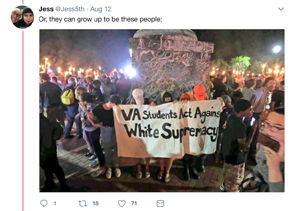 As I sit here writing this post, my heart is once again heavy with the hate displayed in #Charlottesville since Friday night. I replay the sounds and images that flashed across my social media feeds last weekend: white men chanting racist and homophobic slurs, people carrying torches and confederate flags, the face of a young woman who died opposing hate.
As I sit here writing this post, my heart is once again heavy with the hate displayed in #Charlottesville since Friday night. I replay the sounds and images that flashed across my social media feeds last weekend: white men chanting racist and homophobic slurs, people carrying torches and confederate flags, the face of a young woman who died opposing hate.
As a white woman, I know that the work of dismantling the system of white supremacy that flashed across television screens this weekend is not for my friends, family, or colleagues who identify as part of a continually marginalized group. Rather, the work of dismantling the system of white supremacy is an undertaking for my white peers across the country, for me, and especially for educators.
As a former elementary educator in post-Katrina New Orleans and now as a researcher in a racially and linguistically diverse Midwestern school, I know that discussing instances of racially motivated violence in the classroom can feel overwhelming, scary, and uncomfortable. Yet, to not take a critical stance on such issues and to engage the children and young people in our classrooms in such conversations is similar to covering a damaged floor with a beautiful rug—without seeing it, we can pretend that it is not there. In the same way that it takes effort to repair a damaged floor, we must roll up our sleeves to address these realities if we ever wish to make do on reparations.
For classroom teachers, especially those working in an environment wherein colleagues or students actively voice racist, homophobic, or other hateful views, the idea I am presenting likely feels impossible. I would suggest, however, that this is where technology in literacy education may serve us well. Since leaving the classroom five years ago, I have learned from many teachers and scholars online through Instagram, Twitter, and Facebook.
Like many of the practitioners I follow, I have developed a professional learning network (PLNs) by participating in frequent Twitter chats and by following teachers on Instagram. Often the content they share addresses specific needs related to discipline or grade-level. Educational scholars have taken to Twitter, Facebook, blogs, and podcasts to make research more accessible to PK–12 educators. But, how might we borrow and build upon ideas for sharing resources from educators and scholars to engage the children and youth we teach in discussions about hate?

When events like Charlottesville occur, many PK–12 and university professionals are quick to share resources for how and why educators must discuss current events with their students. Among the more well-known resources is the Southern Poverty Law Center's Teaching Tolerance, which provides free resources to help educators integrate social justice, anti-bias, and anti-racism education into their curricula. Yet, the rapid change in technology during the last ten years has also allowed for more creative sharing of collective resources. In the aftermath of recent violent acts, various texts, videos, activities, research papers, syllabi, and other resources have been crowdsourced using the hashtag #CharlottesvilleCurriculum.

Not only does this hashtag provide me with materials to use in my own classroom or to share with colleagues, but I frequently grow my PLN as I find individuals willing to challenge the status quo and confront white supremacy head-on. Alternatively, I begin to follow others based on suggestions from peers within and beyond education. Through growing my PLN in this way, I have come across more creative ways to engage children and youth in classroom discussions about hate.

Now, perhaps more than ever before, there are resources readily available for educators—especially my white peers—to discuss critical issues related to race, religion, sexual orientation, gender, ability, etc. With so many materials at hand, we cannot say we do not know how to talk to the children and young adults in our classrooms about such issues. Rather, we must take the time to educate ourselves, to grow our PLN, and to prepare. Not one of us is in this alone nor can even one of us ignore the hate espoused by the men we saw in Charlottesville or the hope provided by national counter-protests. As a recent addition to my PLN noted, “These kids that we teach, they are going to grow up one day. And what we do in our classrooms matters."
 Cassie J. Brownell is a doctoral candidate and Marianne Amarel Teaching and Teacher Education Fellow in the Department of Teacher Education at Michigan State University. A corecipient of a 2015 NCTE-CEE Research Initiative Grant, Cassie’s most recent collaborative project—#hearmyhome—explores how writing with and through sound might help students and teachers attune toward literacies and communities of difference.
Cassie J. Brownell is a doctoral candidate and Marianne Amarel Teaching and Teacher Education Fellow in the Department of Teacher Education at Michigan State University. A corecipient of a 2015 NCTE-CEE Research Initiative Grant, Cassie’s most recent collaborative project—#hearmyhome—explores how writing with and through sound might help students and teachers attune toward literacies and communities of difference.